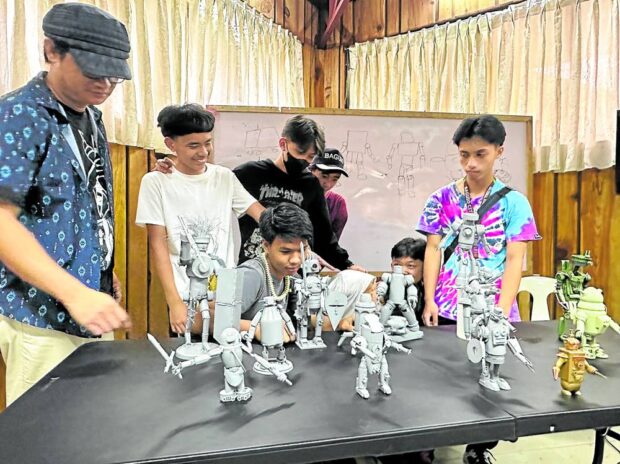
TREASURED TRASH | Baguio students turn discarded carpentry waste into toy planes, scrap metal into miniature tanks, plastic into robots and action figures, and used paper into pocket-sized art which are on exhibit at the Baguio Museum. (Photo by JOEL ARTHUR TIBALDO / Contributor)
BAGUIO CITY, Benguet, Philippines — A group of high school students in the summer capital spent a few days recently turning trash into toys and other works of art.
Seven of them were taught to use construction torches to fuse and reshape scrap metal into heavy miniature tanks, while nine others molded plastic bottles and caps into little robots. The rest produced biplanes (fixed-wing aircraft) using scrap wood or turned small discarded items like buttons or paper into pocket-sized art pieces.
Some of their works of art are exhibited at the Baguio Museum. But it was their time and effort that were crucial to testing a proposed module being developed for grade schools and high schools that would introduce upcycling in campuses.
The draft module would show the “Thunberg generation” another way of reusing waste, said project leader Joel Arthur Tibaldo, a member of Cordillera News Agency which spearheaded this school initiative with the National Commission for Culture and the Arts (NCCA).
He was referring to Swedish climate activist Greta Thunberg, now 20 years old, who had inspired youths across the globe when she publicly denounced world leaders for failing to act on the climate crisis. She began picketing the halls of the Swedish government at the age of 15, and had jump-started a world youth movement that advocates climate justice.
The exhibit is the culmination of a workshop on upcycling which is being turned into a school module by local artists and will focus on the importance of environmental conservation. (Photo by JOEL ARTHUR TIBALDO / Contributor)
Preoccupation
Tibaldo said upcycled art could be a new “preoccupation for teenagers that would guide them toward actively promoting climate action.” Upcycling is a process of repurposing waste like cardboard, plastic bottles, torn fabric, scrap metal or discarded wood into practical items like clothing, home décor or even toys.
The module, which is still being fine-tuned, would provide students with insights about “global and local trends and interventions” regarding waste generation, according to a project fact sheet.
It also introduces them to “elements of design” to explain concepts like “form and shape, texture, balance, pattern, variety, proportion and contrast.”
Upcycling also allows the students to recycle “scrap metals, wires, automotive and plumbing parts; bottles, ceramics, discarded accessories and used clothes; plastics, pipes, paper and other discarded household items; and wood, broken furniture and fixtures, and other found objects,” according to the module.
Once finalized, the module would be transmitted to the NCCA. Tibaldo hopes it draws the attention of the Department of Education.
The teens are Grade 11 students who took part in a workshop in June, said Tibaldo, a retired Department of Trade and Industry employee and curator of the Baguio Newseum who dabbles in metal craft.
BETTER IN 3D | Mixed media artist Brenda Subido-Dacpano shares her skills with Baguio
students at using scrap cardboard and discarded materials like buttons and bottle caps to form three-dimensional art. (Photo by JOEL ARTHUR TIBALDO / Contributor)
He mentored Kenneth Cablarda, Darhyl Tanobong, Niwane Yuri, Rojan Fernandez, George Gameo Jr., Yuan Allidem and Andrew Pistola, who composed the team that upcycled metal scraps.
Rodmar Jhon Ortega, Frenzhelle Kurt Laruan, Jimpol Mariacos, Hendrix Tolabis, Justine Calderon, James Frank Datu, Dexter Galap, Jeb Siano and Earl Jacob Alcantara were tutored on plastic toy-making by illustrator and toy collector Aurelio Castro III.
Architect Dulthe Carlo Munar and mixed-media artist Brenda Subido-Dacpano were mentors to the remaining 27 teens, who produced biplanes, racing cars and birdhouses made of carpentry waste, pocket-sized portraits and three-dimensional mixed-media pieces.
In that batch were Ardel Sampaga, Harry Hernandez, Ethan Josh Delico, Larry Baldera Jr., Geo Caco, Mark Clarence Abalos, Jayshell Joy Cantono, Ivy Delos Santos, Colby Brent Balumaga, Jhovane Hilario, Billy Antero, Casey Kein Bosaing, Jefferson Lorenzana and Chrysler Rado Ayban.
Also in the group were Jhan Lloyd Ducuson, Jammil Bien Lorenzo, Zell Denver Ozamis, Mark Larry Suniga, Ken Lister Jallores, Israel Horacio, Patrick Micder, Aljhay Mining, Jerome Padsuyan, Stephen Lewis Marcelo, Justine Castaneto, Cario Graido and Aeron Catapang.
TOYS FROM SCRAP | Debris can be beautiful, points out architect Dulthe Carlo Munar when he discussed how discarded carpentry materials can still be reshaped into toys. (Photo by JOEL ARTHUR TIBALDO / Contributor)
READ: Baguio fire department gets title over parts of Burnham Park
READ: Still no budget for body to guide Baguio, Benguet
Back to nature
Munar said they taught the students to not only create new art but to also know how to “give back to nature.”
For instance, birdhouses made of wooden debris offer shelter to birds that are essential to the ecosystem because they consume insects and distribute seeds, he said.
“The exhibit holds immense potential for reshaping the world,” said businessman Peter Ng, president of the Baguio Museum. “Upcycling is a catalyst for economic growth by creating opportunities for local artisans, small businesses and marginalized communities,” he said.
Solid waste is also a serious concern in Baguio, which spends up to P200 million annually to haul garbage to local landfills in Tarlac or Pangasinan. Recently, the city government has been encouraging households to reduce their daily trash.
A parallel campaign against excessive consumption is being waged by a local zero-waste organization.
METALWORK Students learn basic metalwork when a group of artists tested a potential school module that introduces upcycling and the impact of climate change. (Photo by JOEL ARTHUR TIBALDO / Contributor)
Used plastic bottles, caps, and containers are resurrected as toys. (Photo by JOEL ARTHUR TIBALDO / Contributor)